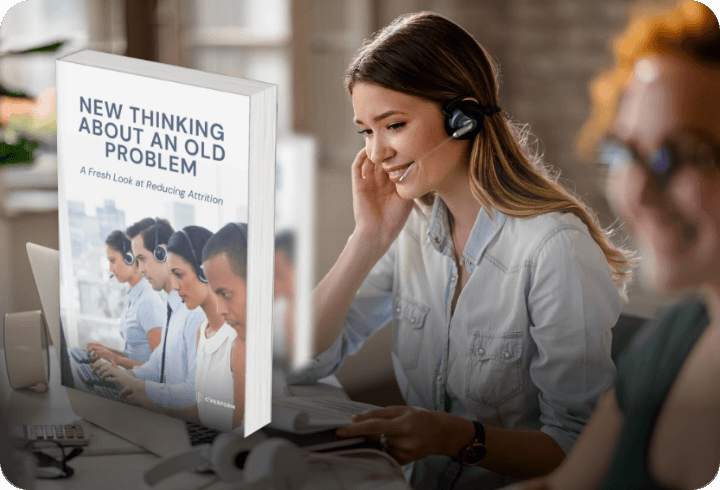For any call center, employee recruitment is a major concern. With average call center turnover falling between 30% and 45% (Source: QATC), call center leadership is constantly pressured to add new talent and improve retention rates for existing call agents.
One tip that some top-performing call center managers have for others to improve employee retention is to work on their employee onboarding practices. What does employee onboarding have to do with retention? How can you ensure that your onboarding process prepares your new call center agents for success?
Why Employee Onboarding Matters
Let’s start with a hypothetical example. The following story is a work of fiction. Any resemblance to real persons or businesses is purely coincidental.
Samantha (Sam) is a new call center agent at XYZ Electronics, a major reseller of electronic gadgets and tech services. The company’s flagship offer is a yearly subscription for tech support services for buyers of their custom computers that offers free unlimited support, troubleshooting, and repair to customers.
When Sam was hired, she was part of a large batch of new hires that were all funneled into a shiny new call center. While she had some passing familiarity with the company’s products from ads and other publicly-available info, she wasn’t given any initial training beyond “Here’s your phone, this is the calling app and script, and you need to make X calls per hour. I’ll be busy, so figure out the rest on your own.”
Without a clear understanding of the company’s products and services, the kind of prospects she would be interacting with, or even which specific products/services to focus on, Sam struggles to close deals. This leads to poor performance reviews that drag down her motivation—creating a vicious cycle where she struggles to meet expectations, gets reprimanded for lack of results, and performs worse on calls because of her flagging morale and loss of confidence.
Despite working hard and making more calls than other new hires, Sam continues to perform poorly. After just a couple of months, she puts in her two weeks’ notice and moves on to a new position at a different company.
The new company, ABC Soft, has a completely different onboarding process. Sam is thoroughly vetted prior to being hired, asked numerous questions during a one-on-one interview and goes through some role-playing sessions before she ever picks up a phone for her new employer.
She’s initially partnered with a more experienced call center agent and shown the ropes, given lessons about the company’s software, their unique selling proposition, and what their main sales focuses are for the quarter. She’s also provided with explanations about the most common objections to the company’s sales pitches are and some tips for dealing with them.
After her first week of flying solo, sheundergoes some coaching where her new manager walks her through a couple of calls she had during that time. During the coaching session, her manager highlights some of the things she did well and points out a few things she could do better—providing specific tips based on what their highest-performing sales team members do.
A few months later, Sam is crushing her sales goals and being asked to help mentor the next batch of new hires.
A few years later, Sam is being recognized as one of the call center’s top agents—having produced enormous results for ABC Soft. Meanwhile, XYZ Technology continues to struggle to keep call center agents for more than a few months at a time and has declining sales.
What was the major difference? One company had managers who knew how to onboard new employees consistently thanks to having an employee onboarding playbook. Meanwhile, the other business left the process up to individual managers and didn’t enforce any kind of official policy for acclimating new agents.
The Simplified Call Center Employee Onboarding Playbook
Having an employee onboarding guide, playbook, checklist, etc. can make an enormous difference in the consistency of your new hires’ performance. But, what should you include in your playbook?
Here are a few basic sections that every call center’s new hire onboarding playbook should address:
Setting Expectations
What is the new person expected to do once they’re on the job? What are their goals? How is success measured? Will there be rewards for above average performance? Will they have support from other team members and/or management? What tools will they have to know to get things done?
Before work can begin in earnest, call center agents need to have answers to these questions. Unfortunately, many employees don’t really know what’s expected of them at work. In fact, Gallup reports that “only about half of employees strongly agree that they know what is expected of them at work.”
Managers (or specialized onboarding teams) can play a crucial role in setting employee expectations—helping prepare them for long-term success in their new role. This can include doing things like sitting down with new employees to explain the company’s current focus and mission statement, providing additional employee training on KPIs and how to meet them, or holding a Scrum meeting with the whole team at each shift’s start to discuss results and priorities.
Providing Resources
What does the employee need to have access to in order to meet their job responsibilities? Have they been provided with all of the resources they need? For a contact/call center, some common resources that you might need to provide the new agent with include:
- Service software logins
- Computer, phone, and other hardware
- Videoconferencing logins
- Orientation playbook
- Call scripts
- Employee email account
- Productivity tool logins (team communication app, performance tracking solution, etc.)
These are just a few examples of the resources that a new hire might need access to at the start of their first day. Some managers like to create a checklist of these items and mark them off as they verify that a new hire has received access to each mission-critical tool they need. This can actually help with documenting onboarding processes.
Documentation for Onboarding Processes
Having a documented process can help ensure that your onboarding process is consistently carried out to completion for every new hire and not just a portion of them. Documenting processes related to onboarding creates a paper trail that you can use to verify that each new hire is being given the resources and information they need to perform adequately from day one instead of being left to their own devices.
Documentation can also help with earning certain certifications and avoiding labor disputes. For example, although documentation of procedures for “competence, training, and awareness” may not be considered mandatory for ISO 9001:2015 certification, they are often included in ISO 9001 certification applications.
Documenting onboarding processes can also help some companies avoid labor disputes (or minimize their impact) by creating a paper trail showing that employees were given adequate training and resources during onboarding. This helps mitigate the risk of wrongful termination lawsuits if an employee has to be terminated for poor performance.
Identifying Skill Gaps
When a new hire is first brought on board, is there a process for verifying that they have the right skills and knowledge for the job? If call center agents aren’t familiar with all of the tools they need, their call script, or general communication best practices, that could have a major impact on their performance moving forward.
So, having a way to identify skill gaps (and then addressing those gaps) can be crucial for onboarding new call agents. Some ways to check for skill gaps could include:
- Testing employee knowledge during onboarding or new hire orientation
- Performing roleplay sessions during training
- Having senior agents sit in on calls and report back on their findings
- Using voice analytics software to help assess soft skills and agent tone during calls
- Reviewing employee performance metrics to find which KPIs they’re struggling to meet
This can be incredibly useful for providing ongoing guidance to call center agents by helping you address their specific weak points during coaching sessions.
Providing Guidance
If a new employee has skill gaps or is experiencing issues that are keeping them from meeting their goals, how can you help them? Providing guidance in the form of coaching sessions, learning management system content, mentorship programs, and knowledge base articles can be a great way to help new hires improve their results quickly and develop their skills.
Providing this kind of support can also be crucial for making the employee feel more valued—helping drive employee engagement and retention.
Making Adjustments to Employee Onboarding Processes
How successful is your onboarding process at creating high-performing employees out of new hires? How long does it take to move someone from “rookie” status to a sales superstar? What’s the employee perception of the onboarding process and its value to them?
Some of the best call center leaders will periodically review their onboarding process and talk to new hires, experienced call agents, and management to identify ways to improve the onboarding experience and ensure that every new employee has everything they need to achieve success.
For example, you could run an anonymous post-onboarding survey asking questions about the process and requesting potential improvements. This can help make employees feel more involved while giving you valuable insight into how your onboarding processes can be improved.
Need Help Tracking Employee Performance and Providing Guidance in Your Call Center?
Need tools that can help you track employee performance, communicate with them, and provide more valuable coaching while saving time on each of these tasks? Reach out to C2Perform to get started!
Our comprehensive employee performance management platform combines all of the tools you need to track employee performance, optimize coaching sessions, manage learning programs, and more—all under a single solution.
Save time and help your team be better every day with a little help from the most comprehensive employee engagement and performance management platform on the market.
 English
English Español
Español





.png?height=350&name=Untitled%20(300%20x%20175%20px).png)



